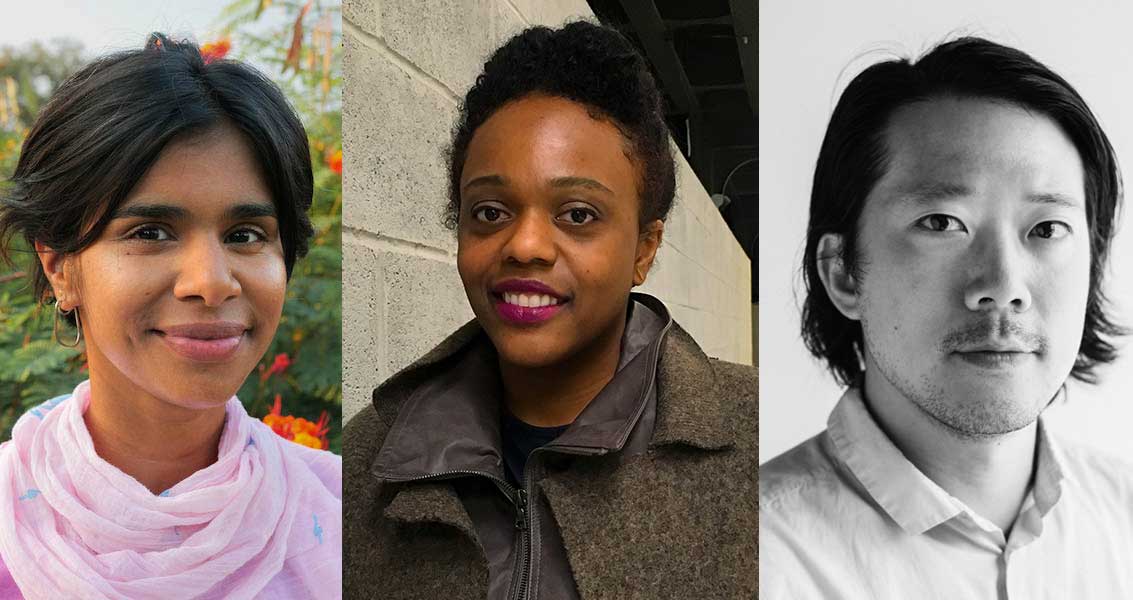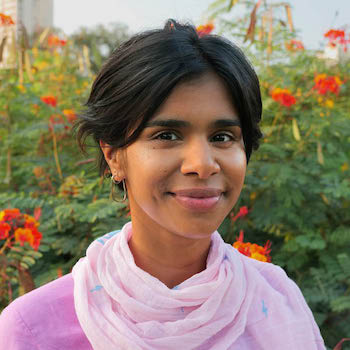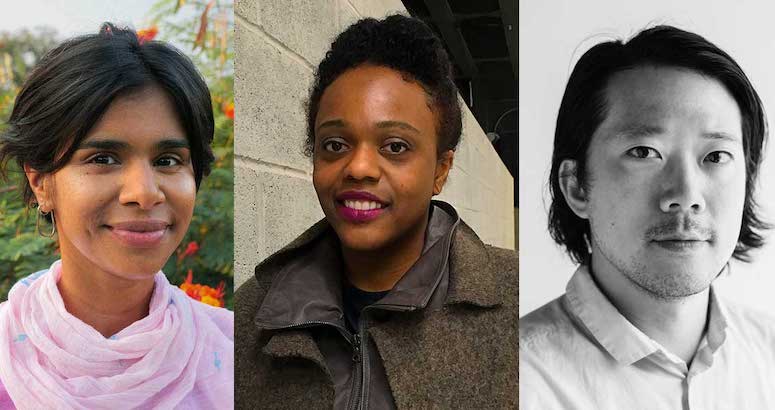
Rice students with an interest in the arts have more opportunities than ever to deepen their knowledge of, skill in and academic understanding of art in all of its forms thanks to ongoing efforts and investments by Rice’s School of Humanities toward arts education at the university.
The Department of Visual and Dramatic Arts, to be renamed the Department of Art later this summer, is set to become an even more vibrant part of the fabric of the university thanks to the upcoming state-of-the-art Susan and Fayez Sarofim Hall — led by Rice alum Charles Renfro ’89’s Diller Scofidio + Renfro — with construction now scheduled to begin in early 2024.
Amid the excitement around the department’s new home, an influx of new faculty (and artists) — including associate professor Leslie Hewitt and assistant professors Kenneth Tam and Sindhu Thirumalaisamy — has already brought more teaching expertise and world-class, award-winning art practices to Rice students.
“The arrival of these three new faculty members in the visual arts in the same year attests to the investment in the arts at Rice,” said Kathleen Canning, dean of humanities and the Andrew W. Mellon Professor of History. “A cluster hire that results in the appointment of three highly accomplished artists, each representing a distinctive and innovative art practice and a remarkable capacity to cross boundaries between art practices, is rare and resulted from the inventive and persistent work of the faculty search committee, which fully embraced and sought to realize its vision of collaborative and interdisciplinary arts practice and arts pedagogy, which will find its realization in the new Sarofim building.
“The arts faculty were already first-rate — let us not forget that the Niche college rankings list the study of art at Rice as No. 5 in the United States — and with the arrival of these three young colleagues, the visual arts will be elevated even further and more students will come to Rice to study art,” Canning continued.
Thirumalaisamy joined Rice last fall, while Hewitt and Tam arrived this January. The three are all cross-disciplinary creators whose work spans mediums, an inherently nonsiloed approach that fits perfectly with the department’s planned shift away from medium-specific concentrations going forward.
Though Thirumalaisamy is a filmmaker by training, she works in a range of mediums including video installation and sound composition. Her 2019 documentary “The Lake and The Lake” about a toxic lake in Bangalore won the jury award for best documentary at the 58th Ann Arbor Film Festival, and her work, which draws from queer and feminist practice and theory, has been exhibited at venues across the world.

Recently, Thirumalaisamy was awarded a prestigious MacDowell Fellowship to join a community of artists in New Hampshire for a month, during which she plans to focus on a new video piece about concrete. This new work is part of a series that also includes her two-channel video installation “Objects in the Mirror: Notes for a Houston Road Movie,” which was shown at the Glassell School of Art at the Museum of Fine Arts, Houston and the Moody Center for the Arts in 2022.
“One way that I think about my work is that I make portraits of places,” Thirumalaisamy said. “But the portraits are not static documents of what’s ‘out there’ — the portraits recompose scales, relationships and intensities through cinematic tools and techniques.”
Thirumalaisamy often works collaboratively as a sound designer. She recently did just that for the video installation “Souvenir” by Ohan Breiding and Shoghig Halajian. To help weave together the memories of a tsunami survivor with the “transoceanic journey of marine organisms,” Thirumalaisamy took marographs — graphic recordings of tide records — gathered by her collaborators and ran them through an open source synthesizer developed by artist olivia jack, allowing her to “play” the tide records.
Hewitt’s art practice also encompasses many mediums — in recent years, she’s made use of photography and sculpture in site-specific installations toward the goal of “exploring time, historical narratives and materials relative to creating a more expansive way of addressing ‘place,’ as well as the kinds of histories that encompass that place.”
Take Hewitt’s “Reading Room,” a 2019 solo exhibition at Perrotin New York, in which she sought to disrupt and complicate preconceived notions about images and art objects being solely fixed, static items.
The site-specific installation featured a series of “photo-sculptures,” photographs taken by Hewitt of objects including abstract drawings, books and raw materials such as wood, glass and metal, in large custom-built wooden frames that lean against the gallery’s walls. Hewitt’s photo-sculptures were juxtaposed with several original steel sculptures, each industrially fabricated and folded in various points at 90-degree angles, intentionally scattered across the gallery floor to inspire reflection on themes including navigation and orientation within a built environment.

Or consider Hewitt’s ongoing site-specific installation at New York’s Dia Bridgehampton. Inspired by the history of the location and author Tiffany King’s writings, which frame coastal shoals as a conceptual locus and psychological site of resistance by Black and Indigenous communities to historical conquests by white settlers, the artist created large bronze, rocklike sculptures whose designs were derived in reference to bathymetric maps of the Atlantic Ocean. These sculptures were juxtaposed with other related works — including a Fluxus-inspired score in the form of a still-life consisting of a wooden tambourine, a sea shell and visible code displayed in time with a sonic element conceptualized by Hewitt and her collaborator, artist Jamal Cyrus — all housed within a historic building which has served as a firehouse, an African American Baptist church and now a permanent installation by American minimalist artist Dan Flavin.
“I think all of my work connects to a larger arc,” Hewitt said, “and a commitment to thinking about the ways in which memory — historical, collective, personal as well as a political imaginary — collide, and finding a form that can hold the complexity of all.
“Aesthetics play an important role here,” she continued, “alongside notions of tragedy and melancholy. Each project gets closer to finding this precarious and new form.” Hewitt plans to further develop these themes and research in an upcoming survey exhibition at New York’s Guggenheim Museum.
Hewitt and Thirumalaisamy share that same interdisciplinary spirit with their colleague Tam, whose work across video, sculpture, installation, movement, performance and photography examines a wide range of themes. A topic Tam has returned to over the years is the performance of masculinity and the spaces in which intimacy is developed between men, which he’s examined in works centered around rituals practiced by some Asian American fraternities as part of their initiation processes, and in his work “Silent Spikes,” which through a two-channel video weaves together the trope of American cowboy masculinity with both visual and narrative references to the 1867 labor strike by Chinese Transcontinental Railroad workers.
“There’s something ultimately kind of tragic about masculinity as we tend to understand it in the West,” Tam said, “and I find that to be a really compelling subject matter because of that.”

Tam’s interest in the lives and experiences of Chinese railroad workers also led him to the remote, arid clime of West Texas’ Marfa, where he created for Ballroom Marfa the exhibition “Tender is the hand which holds the stone of memory,'' comprised in part of new sculptures he created with materials including objects found at various sites where immigrant Chinese communities once lived. By excavating and reclaiming coins, ceramics and glassware and combining them with horse saddles, leather straps and compressed West Texas dirt, Tam’s work shined a light on these immigrants whose contributions to the development of the American West are oft-ignored; the exhibition was featured by the New York Times earlier this year.
“Every medium has its own particular qualities, its own specialities,” Tam said. “I work across them because I feel like each one has something to add given what it is I’m investigating.”
These three dynamic artists share a unique tie to Houston that predates their arrivals as professors at Rice — each are past members of the Glassell School of Art’s Core Residency Program at MFAH, which not only gave them the opportunity to get to know and work in the nation’s fourth largest city, but also offered them the opportunity to meet Rice students through on-campus teaching opportunities during the fellowship year.
“I was introduced to the Rice campus and was inspired by Rice students,” said Hewitt of her time teaching here during her Core residency. “I believe the students' mode of study and inquiry align fully with the study of contemporary art. Students often double major; this makes the visual arts an interesting and porous site within a university setting.”
Thirumalaisamy was equally inspired by what she’d heard about both Rice’s art department and the thoughtful students from diverse backgrounds and academic interests it tends to attract. “I was introduced to the art department as a place where interdisciplinary work is encouraged,” she said. “I had heard that many of the students were talented double majors, and I really liked that idea that the things students do in art classes might influence a different field in the future.”
The three artists are part of the latest wave of art-minded talent attracted to the university, who were also enticed by the opportunity to join Rice’s faculty knowing they’d get to play large roles along with their many colleagues across the department and across Rice’s campuswide arts endeavors in shaping what art practice and education at Rice will look like for decades to come.
“I thought it was a rare opportunity for someone to get in on the ground floor of planning the future of the department,” said Tam. “That was a major reason why I decided to come to Rice.”
So far, the high hopes of these three recent recruits to campus have been borne out.
“Rice students are intellectually rigorous, curious and kind,” Hewitt said. “That combination works well in an art space, and I think with that, we can collectively start to define what art means in the space of the studio with honesty and courage.”
“It’s very energizing to be in the classroom with them,” Thirumalaisamy said, echoing Hewitt’s appraisal of Rice arts students as thoughtful, willing collaborators and pupils whose wide-ranging academic and personal interests create an ideal starting point for artistic exploration.
“Rice students are really talented, hard-working individuals,” Tam said, something he appreciated during his time teaching on campus during his Core residency and continues to see with every new batch of students. “They’re very bright, engaged and curious, and they’re willing to put in the effort to fill in the gaps in their educations. They also bring with them a lot of knowledge from other areas outside of visual art, and that can inform what they do and create some interesting outcomes.
“It also challenges me to think outside of my comfort zone of thinking only within a space of art discourse, so it’s rewarding on both ends.”
These fruitful collaborations are sure to continue blossoming in the years to come, creating a thrilling future for both the art department and for the arts as a whole across campus.
“Already, in their very brief time at Rice, these three outstanding artists have had a significant impact on the arts at Rice,” Canning said. “We anticipate that student interest in visual arts will continue to grow and that future hires will be necessary to meet rising demand on the part of Rice students, who are increasingly tapping into their creative capacities as arts majors. The arts and creative writing are fundamental to the goals and aspirations of our school and we look ahead to an exciting future as the Sarofim building becomes a reality.”

